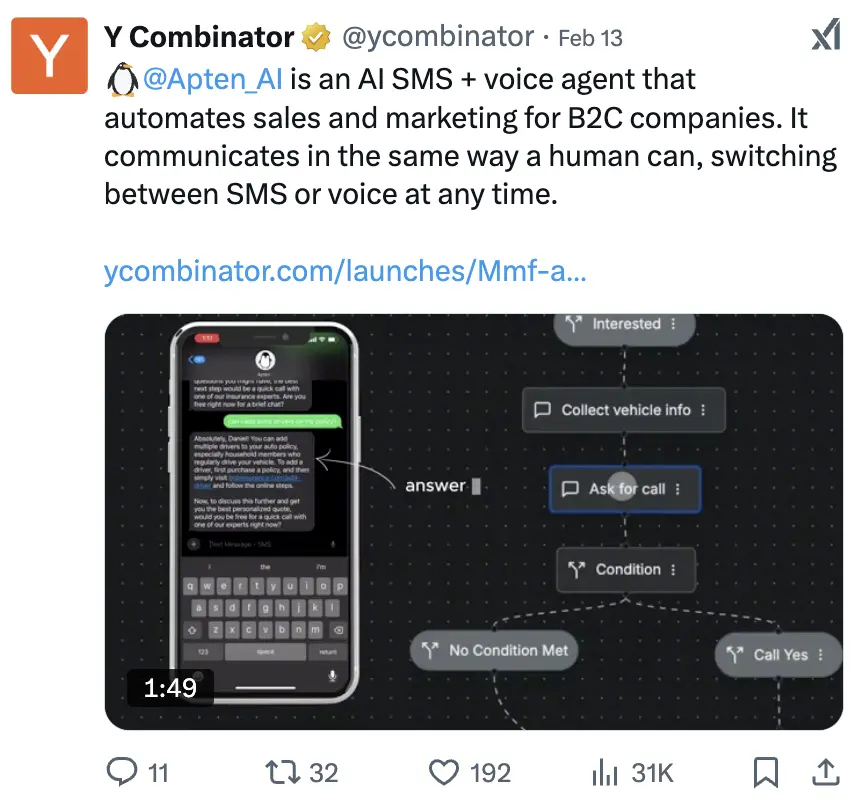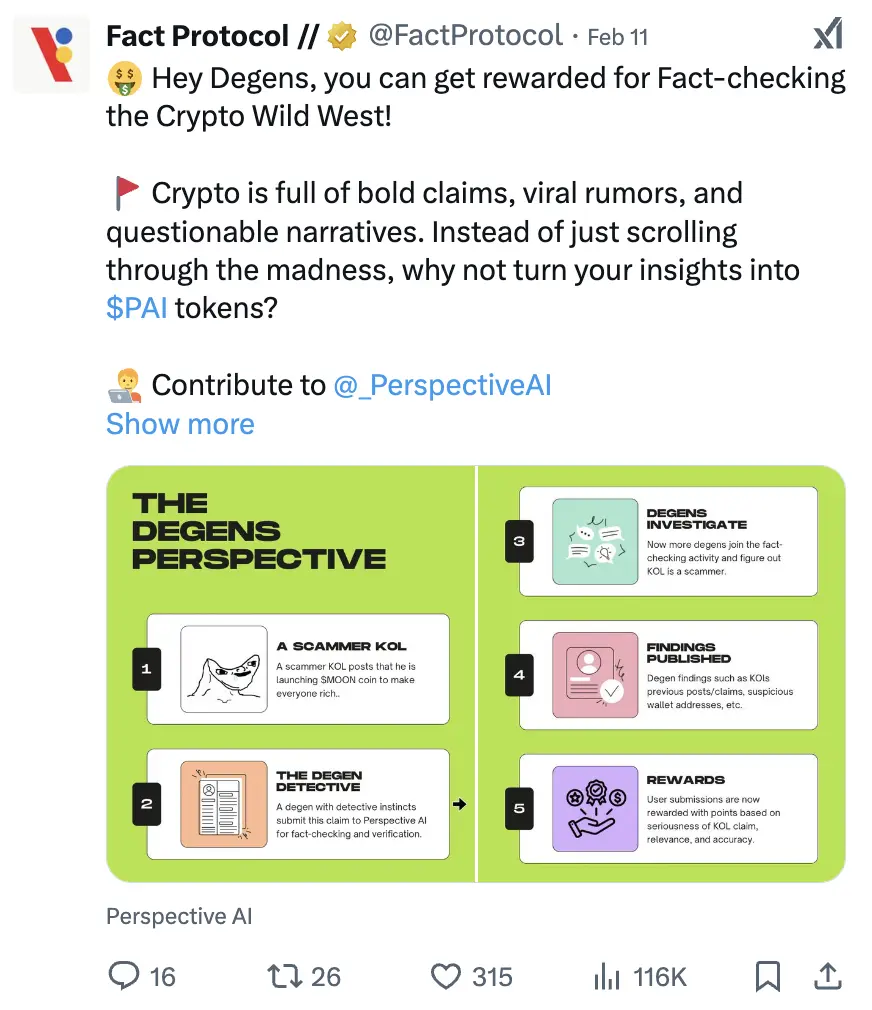The AI track is a little tired, will the vertical Agent break the deadlock?
Web3 vertical AI agent: potential beyond Web2
This article discusses the application differences between AI agents in Web2 and Web3 and the future potential of Web3 agents. Web2 has widely used AI agents to improve efficiency, covering sales, marketing and other fields, and has achieved significant cost reduction and efficiency improvement. However, Web3 has given AI agents new application scenarios by integrating blockchain technology, especially in the DeFi field.
Web3 agents have the potential to surpass Web2 agents using token incentives, decentralized platforms and on-chain data. Although Web3 agents are currently facing challenges in market adoption and profit model, their unique decentralized advantages and community-driven growth model make it expected to compete with Web2 in the medium and long term, and even reshape the industry landscape.
Web2 AI agent application case:
Many companies have applied AI agents to their daily operations, such as:
-
Apten_AI: AI-based SMS agent for sales and marketing.

-
Bild_AI: Read architectural blueprints, extract material and specification data, and estimate costs.

-
Casixty: Marketing agents, identify Reddit hot topics, automate replying, and increase brand participation.

These cases demonstrate the transformation role of AI agents in traditional industries, realizing task automation and workflow optimization.
Web3 AI agent: more than just chatbots
Web3 agents are no longer limited to simple chatbots, but integrate with various tools and plug-ins to perform more complex operations:
- sendaifun: Solana AI Intelligent Suite supports from basic token management to complex DeFi operations.
- ai16zdao: Integrates over 100 plug-ins, covering social media interactions, automated transactions and DeFi operations.
- Cod3xOrg, @Almanak__: No-code infrastructure that allows users to create autonomous transaction agents.
- gizatechxyz: An independent DeFi assistant customized for investors.
DeFi is the most promising application area for Web3 AI agents. Agents not only simplify user experience, but also use on-chain data to create new opportunities. The structured data provided by blockchain (transaction history, governance activities, etc.) enables AI to analyze data, automate workflows, and improve decision-making capabilities.
The integration of Web2 vertical agent and encryption native model:
The launch of virtuals_io on Solana is a typical case. For example:
-
_PerspectiveAI: AI-driven truth verification tool, continuous improvement.

-
Roboagent69: Personal assistant, booking flights, taxis, etc.

-
HeyTracyAI: AI-driven sports reviews and analysis.

These agents usually use token gating mechanism, and users need to pledge tokens to obtain advanced permissions.
Competition between Web3 AI agents and Web2 startups:
In the short term, Web3 intelligentsia faces challenges in market acceptance and profitability. But in the long run, the Web3 model has the following advantages:
- Community-driven growth: Through token incentives and interest alignment.
- Global Accessibility: Decentralized and unmanaged platforms lower the threshold for use.
The rise of open source AI has also accelerated the integration of encryption and AI.
Key application scenarios for encrypting native AI agents:
- DeFAI: Abstraction layer, automated trading agent, and pledge/lending solutions.
- Research and reasoning agent: AI-driven research assistant that analyzes data and generates actionable insights.
- Data-driven AI agent: Utilize on-chain data and social data to drive independent decision-making.
Conclusion:
Although the market has experienced a pullback, the fundamentals of Web3 agents have gradually become clear. Web2 vertical agents have proven their value, while Web3 agents have great potential. By combining token incentives, decentralization and on-chain data integration, Web3 agents are expected to surpass similar products in Web2. The key lies in whether the Web3 agent can achieve a adoption rate comparable to Web2 and reshape the industry landscape. In the future, the boundaries between Web2 and Web3 vertical AI agents will become increasingly blurred, and teams that successfully integrate the advantages of both will lead the next generation of digital economy.
The above is the detailed content of The AI track is a little tired, will the vertical Agent break the deadlock?. For more information, please follow other related articles on the PHP Chinese website!

Hot AI Tools

Undresser.AI Undress
AI-powered app for creating realistic nude photos

AI Clothes Remover
Online AI tool for removing clothes from photos.

Undress AI Tool
Undress images for free

Clothoff.io
AI clothes remover

Video Face Swap
Swap faces in any video effortlessly with our completely free AI face swap tool!

Hot Article

Hot Tools

Notepad++7.3.1
Easy-to-use and free code editor

SublimeText3 Chinese version
Chinese version, very easy to use

Zend Studio 13.0.1
Powerful PHP integrated development environment

Dreamweaver CS6
Visual web development tools

SublimeText3 Mac version
God-level code editing software (SublimeText3)

Hot Topics
 An efficient way to batch insert data in MySQL
Apr 29, 2025 pm 04:18 PM
An efficient way to batch insert data in MySQL
Apr 29, 2025 pm 04:18 PM
Efficient methods for batch inserting data in MySQL include: 1. Using INSERTINTO...VALUES syntax, 2. Using LOADDATAINFILE command, 3. Using transaction processing, 4. Adjust batch size, 5. Disable indexing, 6. Using INSERTIGNORE or INSERT...ONDUPLICATEKEYUPDATE, these methods can significantly improve database operation efficiency.
 Steps to add and delete fields to MySQL tables
Apr 29, 2025 pm 04:15 PM
Steps to add and delete fields to MySQL tables
Apr 29, 2025 pm 04:15 PM
In MySQL, add fields using ALTERTABLEtable_nameADDCOLUMNnew_columnVARCHAR(255)AFTERexisting_column, delete fields using ALTERTABLEtable_nameDROPCOLUMNcolumn_to_drop. When adding fields, you need to specify a location to optimize query performance and data structure; before deleting fields, you need to confirm that the operation is irreversible; modifying table structure using online DDL, backup data, test environment, and low-load time periods is performance optimization and best practice.
 How to use MySQL functions for data processing and calculation
Apr 29, 2025 pm 04:21 PM
How to use MySQL functions for data processing and calculation
Apr 29, 2025 pm 04:21 PM
MySQL functions can be used for data processing and calculation. 1. Basic usage includes string processing, date calculation and mathematical operations. 2. Advanced usage involves combining multiple functions to implement complex operations. 3. Performance optimization requires avoiding the use of functions in the WHERE clause and using GROUPBY and temporary tables.
 How to uninstall MySQL and clean residual files
Apr 29, 2025 pm 04:03 PM
How to uninstall MySQL and clean residual files
Apr 29, 2025 pm 04:03 PM
To safely and thoroughly uninstall MySQL and clean all residual files, follow the following steps: 1. Stop MySQL service; 2. Uninstall MySQL packages; 3. Clean configuration files and data directories; 4. Verify that the uninstallation is thorough.
 How to analyze the execution plan of MySQL query
Apr 29, 2025 pm 04:12 PM
How to analyze the execution plan of MySQL query
Apr 29, 2025 pm 04:12 PM
Use the EXPLAIN command to analyze the execution plan of MySQL queries. 1. The EXPLAIN command displays the execution plan of the query to help find performance bottlenecks. 2. The execution plan includes fields such as id, select_type, table, type, possible_keys, key, key_len, ref, rows and Extra. 3. According to the execution plan, you can optimize queries by adding indexes, avoiding full table scans, optimizing JOIN operations, and using overlay indexes.
 How to use MySQL subquery to improve query efficiency
Apr 29, 2025 pm 04:09 PM
How to use MySQL subquery to improve query efficiency
Apr 29, 2025 pm 04:09 PM
Subqueries can improve the efficiency of MySQL query. 1) Subquery simplifies complex query logic, such as filtering data and calculating aggregated values. 2) MySQL optimizer may convert subqueries to JOIN operations to improve performance. 3) Using EXISTS instead of IN can avoid multiple rows returning errors. 4) Optimization strategies include avoiding related subqueries, using EXISTS, index optimization, and avoiding subquery nesting.
 How to install MySQL on Linux system
Apr 29, 2025 pm 03:57 PM
How to install MySQL on Linux system
Apr 29, 2025 pm 03:57 PM
Installing MySQL on Linux can be done through the package manager. The specific steps are as follows: 1. On Ubuntu, use apt to update the package list and install the MySQL server; 2. On CentOS, use yum to install the MySQL community version and start the service. After installation, basic configuration needs to be performed, such as setting the root password and creating database and users.
 How does deepseek official website achieve the effect of penetrating mouse scroll event?
Apr 30, 2025 pm 03:21 PM
How does deepseek official website achieve the effect of penetrating mouse scroll event?
Apr 30, 2025 pm 03:21 PM
How to achieve the effect of mouse scrolling event penetration? When we browse the web, we often encounter some special interaction designs. For example, on deepseek official website, �...











